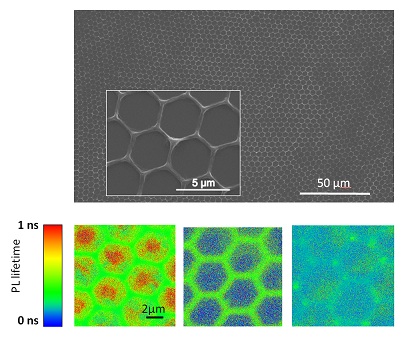Scientists from the Brookhaven National Laboratory in the US Department of Energy have developed thin transparent layers that are able to absorb sunlight and convert it into an electric charge due to a relatively large area

Scientists from the Brookhaven National Laboratory in the US Department of Energy have developed thin transparent layers capable of absorbing sunlight and converting it into an electric charge due to a relatively large area. The new material, described in an article published in the scientific journal Chemistry of Materials, could be used to develop transparent solar panels or even windows that absorb energy from the sun and generate electricity from it.
The new material consists of a semiconducting polymer in which high-carbon fullerenes are embedded. Under strictly controlled conditions, the material self-organizes to obtain a repeating pattern of hexagonal-like micro cells over a relatively large area (even to the extent of several millimeters).
"Although such honeycomb-shaped thin layers have been prepared in the past using ordinary polymers such as polystyrene, this is the first ever report of such a material consisting of a mixture of semiconductor and fullerenes, which manages to absorb light and efficiently convert it into separate electrical charges," said the lead scientist. Mircea Cotlet, physical chemist at the Center for Functional Nanomaterials.
Moreover, the material remains largely transparent since the polymer chains are tightly packed only at the ends of the hexagons, while the rest of the material remains loosely packed and extends across the centers. "The densely packed edges absorb light extensively and may even promote electrical conduction," explains the researcher, "while the centers do not absorb light to a significant extent and are relatively transparent."
"The combination of these properties and obtaining extensive regular patterns could provide a wide variety of possible applications, such as electricity-generating solar windows, transparent solar panels, and new types of optical displays," said one of the scientists involved in the research. "Imagine a house composed of such a material, which, together with a solar roof, could significantly save electricity costs. The subject is quite fascinating," adds the researcher.
The researchers prepared the thin layers by flowing micrometric water droplets across a thin layer of a polymer/fullerene mixture solution. These water droplets organize independently into extensive arrays within the polymer solution. When the solvent is completely evaporated, the polymer forms a honeycomb-like hexagonal pattern across a large area. "This is an economical method and has the potential to move from the laboratory to an industrial scale," explains one of the researchers.
The scientists verified the uniformity of the hexagonal structure using several methods of electron microscopy and scanning detectors, and examined the optical characteristics and charge separation in different parts within the structure (edges, centers and corners, through which the different cells connect to each other) using advanced fluorescence microscopy.
The scientists also found that the degree of packing of the polymer is determined by the rate of solvent evaporation, which in turn determines the rate of charge transfer within the material.
"The slower the rate of evaporation, the more densely packed the polymers are, and thus the greater the charge transfer efficiency," explains the researcher.
"Our research provides a deeper understanding of the optical properties of the honeycomb-like structure. The next step will be to use these thin layers to make flexible and transparent organic solar cells and other devices," said the researcher.
The news about the study

5 תגובות
Indeed, great.
I live in a rented house without a solar heater.
Let them start from here.
only in Israel
They will not make use of the above invention.
Ami, if you haven't been answered until now, it's a sign that someone has a spoon in the basement and is quickly formulating your idea.. My suggestion is let's catch it while it's hot and organize some good stuff for retirement!
If I remember you correctly then you are laughing at the whole thing!
By the way, I have another proposal, and that is to convert the electrical energy produced in the window (in one of the hottest towers in the summer) to cool the window itself and thus the windows will become cooling surfaces... themselves and their immediate surroundings, Dino!
So maybe your idea is needed after all, if there is gas between them to cool, etc
And if it is given then heating in the winter..but that seems to me to be too much of a demand
Best wishes and success
It is also possible to use this material on top of eyeglass lenses and charge the generated electricity directly to the Better Place electric bike.
After reading this article, I developed an amazing method that I intend to anchor with an exclusive patent for doubling the electrical production capacity of the transparent window products!!! Yes, doubling. 2 times! 100%
Well, I give in - I'm ready to find out what the method is and not anchor it in a patent. I was thinking about… double glazing.
It is also a temperature insulator not bad at all
Greetings friends,
Ami Bachar